 W
WThe Beacon Hill Monument is installed in Boston's Beacon Hill, in the U.S. state of Massachusetts.
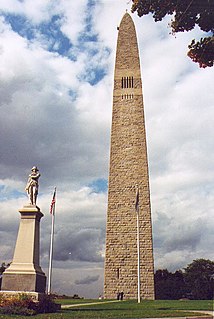 W
WThe Bennington Battle Monument is a 306-foot-high (93 m) stone obelisk located at 15 Monument Circle, in Bennington, Vermont, United States. The monument commemorates the Battle of Bennington during the American Revolutionary War.
 W
WThe Bigelow Monument is a public monument in Worcester, Massachusetts, United States. The monument, located in a small cemetery at the center of Worcester Common, honors Timothy Bigelow, a Patriot during the American Revolutionary War. The monument was dedicated on April 19, 1861, the 86th anniversary of the start of the war.
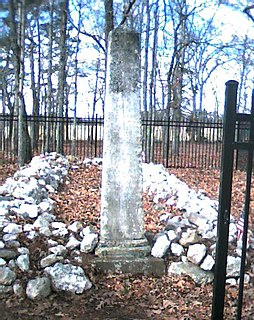 W
WBuford's Massacre Site, also known as Buford's Battleground, is a historic site and national historic district located near Lancaster, Lancaster County, South Carolina. Two monuments now mark the Buford Battleground. A white monument ten feet tall, erected on June 2, 1860, marked the American gravesite. This marker became so scarred from chippings of souvenir hunters that a new monument was erected on May 1, 1955, bearing the same inscription. Buford's Massacre was one of the many vicious actions that characterized the Revolutionary War campaigns in the backcountry South. This particular battle became a symbol of British atrocities and Banastre Tarleton became known as “Bloody Tarleton.”
 W
WThe Bunker Hill Monument is a monument erected at the site of the Battle of Bunker Hill in Boston, Massachusetts, which was among the first major battles between British and Patriot forces in the American Revolutionary War. The 221-foot granite obelisk was erected between 1825 and 1843 in Charlestown, Massachusetts, with granite from nearby Quincy conveyed to the site via the purpose-built Granite Railway, followed by a trip by barge. There are 294 steps to the top.
 W
WThe Cape Henry Memorial commemorates the first landfall at Cape Henry, in Virginia Beach, Virginia, of colonists bound for the Jamestown settlement. After landing on April 26, 1607, they explored the area, named the cape, and set up a cross before proceeding up the James River. A stone cross, set up in 1935 by the Daughters of the American Colonists, stands in the quarter-acre site. The memorial marks the First Landing, the very beginning of what would become British North America and subsequently Anglo Canada and the United States of America.
 W
WCasimir Pulaski Monument in Savannah, or Pulaski Monument on Monterey Square, is a 19th-century monument to Casimir Pulaski, located in Monterey Square, on Bull Street, Savannah, Georgia, not far from the battlefield where Pulaski lost his life during the siege of Savannah.
 W
WThe Dorchester Heights Monument is a large public monument in the Dorchester Heights area of Boston, Massachusetts, United States. The monument, consisting of a 115-foot (35 m) marble tower, honors the evacuation of Boston during the American Revolutionary War, an early American victory in the conflict. The monument is located near where George Washington ordered the construction of a redoubt, an area which has since been developed as a public park. It was designed by the architectural firm of Peabody & Stearns and was dedicated on March 17, 1902.
 W
WEthan Allen is a marble sculpture of Ethan Allen by Larkin Goldsmith Mead.
 W
WThe Fort Vengeance Monument Site is an archaeological and commemorative site on United States Route 7 in northern Pittsford, Vermont. The site includes the archaeological remains of one of Vermont's oldest documented homesteads, and the only surviving site of a military fortification of the American Revolutionary War. The site is marked by a stone memorial placed in 1873, and was listed on the National Register of Historic Places in 2006.
 W
WThe Groton Monument, sometimes called the Fort Griswold Monument, is a granite monument in Groton, Connecticut. It is dedicated to the defenders who fell during the Battle of Groton Heights on September 6, 1781. The monument was originally 127 feet (39 m) high, but it was changed in 1881 to commemorate the centennial of the Battle of Groton Heights; the cupola was removed and replaced by an iron-capped pyramid in emulation of the Bunker Hill Monument. The Groton monument bears a plaque describing the events of the Battle of Groton Heights, and another plaque with the names of the Americans who died in the battle. Lightning destroyed the capstone in 1918 and damaged the adjacent Monument House Museum which features exhibits about the Revolutionary War. Visitors can climb the monument and visit the museum from Memorial Day through Labor Day. The Groton Monument is located in Fort Griswold Battlefield State Park, which includes Fort Griswold.
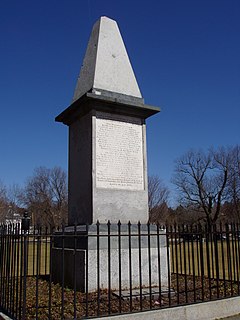 W
WThe Lexington Battle Green, also known as Lexington Common, is the historic town common of Lexington, Massachusetts, United States. It was at this site that the opening shots of the Battles of Lexington and Concord were fired on April 19, 1775, starting the American Revolutionary War. Now a public park, the common is a National Historic Landmark.
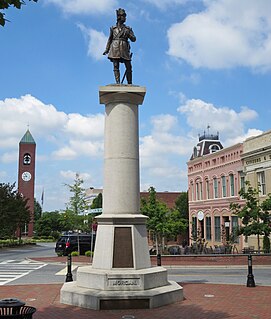 W
WDaniel Morgan Monument is a historic monument located at Spartanburg, Spartanburg County, South Carolina. The statue was designed by John Quincy Adams Ward and the monument erected in 1881. The monument commemorates the centennial of the victory at the Revolutionary War Battle of Cowpens and its hero, General Daniel Morgan. The statue stands on a columnar granite shaft on an octagonal base designed by noted Charleston architect, Edward Brickell White. In 1960, the monument was moved about 100 yards across Morgan Square to its east end. However, in 2005 as part of a larger project involving the redesign and reconstruction of Morgan Square, the monument was returned to its original position at the corner of West Main and Magnolia Streets and its original orientation, facing Cowpens National Battlefield.
 W
WThe Nathanael Greene Monument is a public monument in Savannah, Georgia, United States. Located in Johnson Square, the monument was designed by William Strickland and honors Nathanael Greene, a general in the Continental Army during the American Revolutionary War. While the cornerstone was laid in 1825, the monument was not completed until 1830, at which time it served as a joint monument for Greene and fellow Continental Army general Casimir Pulaski. The monument became solely dedicated to Greene in 1853, after which two bronze plaques honoring Greene were added to the structure. In 1902, Greene's body was reinterred under the monument. In 2018, one of the bronze plaques was vandalized with googly eyes, which drew national attention to the monument.
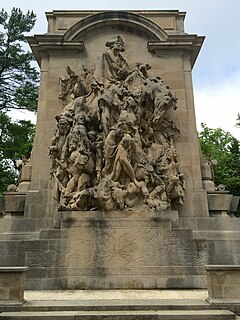 W
WThe Princeton Battle Monument is located in Princeton, New Jersey, adjacent to Morven and Princeton's borough hall. The Monument commemorates the January 3, 1777 Battle of Princeton, and depicts General George Washington leading his troops to victory and the death of General Hugh Mercer. It stands 50 feet (15 m) tall and was inspired by carvings on the Arc de Triomphe in Paris. Designed to visually anchor the western end of Nassau Street, the monument and its park are a legacy of the City Beautiful movement.
 W
WThe Prison Ship Martyrs' Monument is a war memorial at Fort Greene Park, in the New York City borough of Brooklyn. It commemorates more than 11,500 American prisoners of war who died in captivity aboard sixteen British prison ships during the American Revolutionary War. The remains of a small fraction of those who died on the ships are interred in a crypt beneath its base. The ships included HMS Jersey, Scorpion, Hope, Falmouth, Stromboli, Hunter, and others.
 W
WThe Revolutionary War Door is an artwork by American sculptor Thomas Crawford, located on the United States Capitol House of Representatives wing east front in Washington, D.C., United States. This sculptured door was surveyed in 1993 as part of the Smithsonian's Save Outdoor Sculpture! program.
 W
WThe Saratoga Battle Monument is a 155-foot (47 m) granite obelisk located in the village of Victory, Saratoga County, New York. The monument commemorates what is called the "Turning Point" of the American Revolution—the surrender of British forces led by General John Burgoyne to the Americans under General Horatio Gates.
 W
WSigners Monument is a granite obelisk located in Augusta, Georgia, on Greene Street. Signers Monument recognizes Georgia's three signatories of the United States Declaration of Independence: George Walton, Lyman Hall, and Button Gwinnett.
 W
WThe William Moultrie statue is a monumental statue in Charleston, South Carolina, United States. Located in White Point Garden, the statue was unveiled in 2007 and honors William Moultrie, a general in the American Revolutionary War.
 W
WThe Stewart–Screven Monument is a monument in Midway, Georgia, United States. Erected in 1915, the monument honors Daniel Stewart and James Screven, two generals from the American Revolutionary War. The monument is located in a cemetery in the Midway Historic District.
 W
WThe Defenders of Fort Moultrie, also commonly known as the Jasper Monument, is a monument in Charleston, South Carolina, United States. Located in White Point Garden, the monument depicts Sergeant William Jasper and was dedicated in 1877 to all South Carolina militiamen involved in the Battle of Sullivan's Island during the American Revolutionary War.
 W
WThe Tomb of the Unknown Revolutionary War Soldier, also known as the Tomb of the Unknown Soldier of the American Revolution, is a war memorial located within Washington Square in Philadelphia, Pennsylvania. The memorial honors the thousands of soldiers who died during the American Revolutionary War, many of whom were buried in mass graves in the square. The tomb and Washington Square are part of Independence National Historical Park.
 W
WThe Trenton Battle Monument is a massive column-type structure in the Battle Monument section of Trenton, Mercer County, New Jersey, United States. It commemorates the December 26, 1776, Battle of Trenton, a pivotal victory for the Continental forces during the American Revolutionary War.
 W
WThe William Jasper Monument is a monument honoring William Jasper in Savannah, Georgia, United States. Located in Madison Square, the monument was designed by Alexander Doyle and dedicated in 1888.
 W
WWyoming Commemorative Association was founded in 1878 to commemorate the 100th anniversary of the Battle of Wyoming. This American Revolutionary War battle was fought on July 3, 1778, near Wilkes-Barre in present-day Exeter, Pennsylvania.